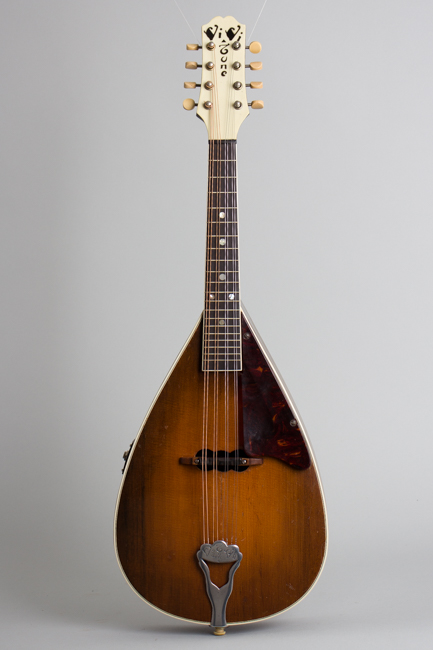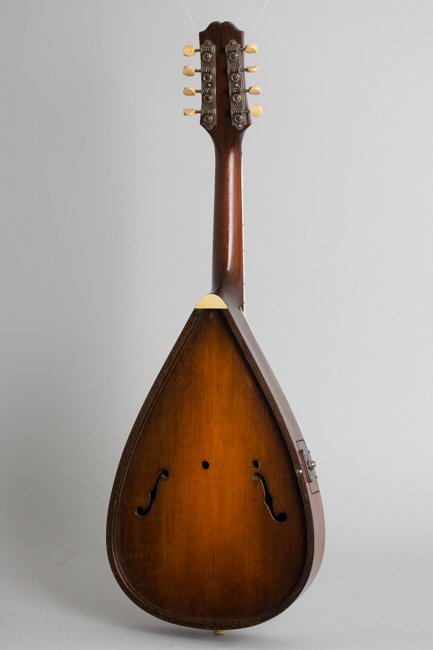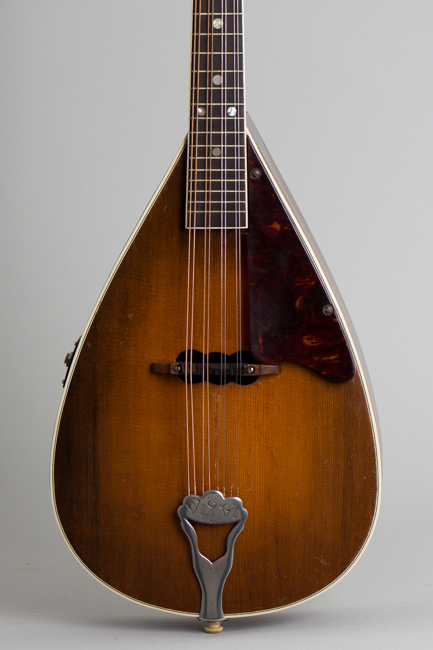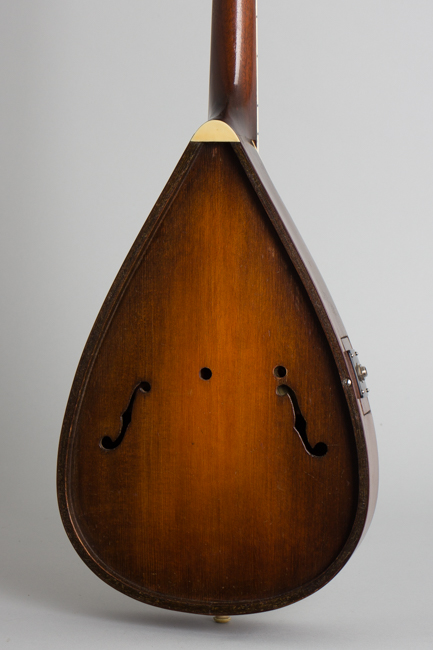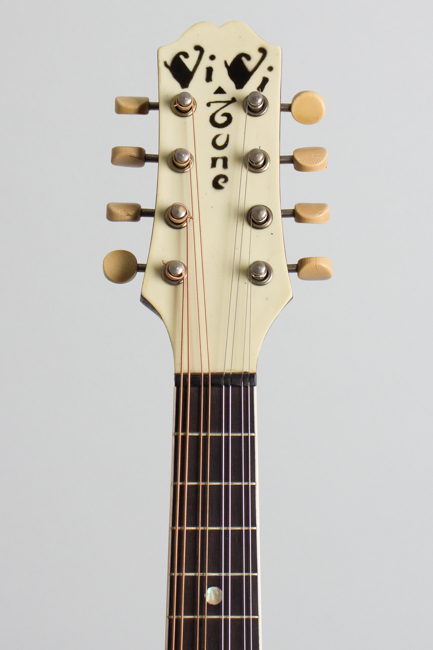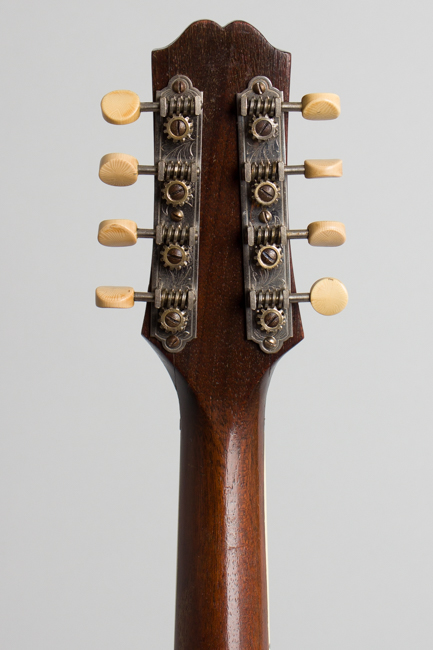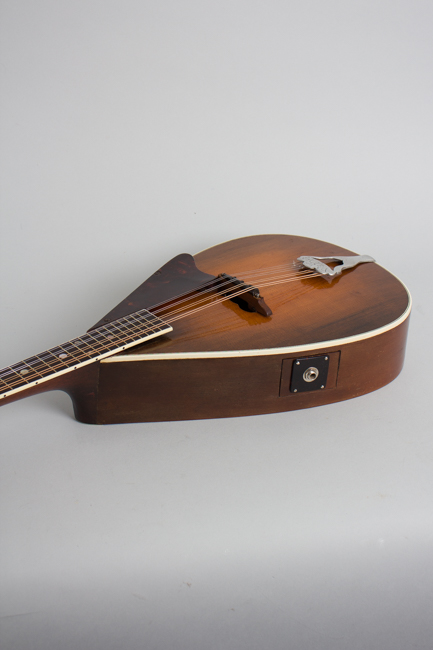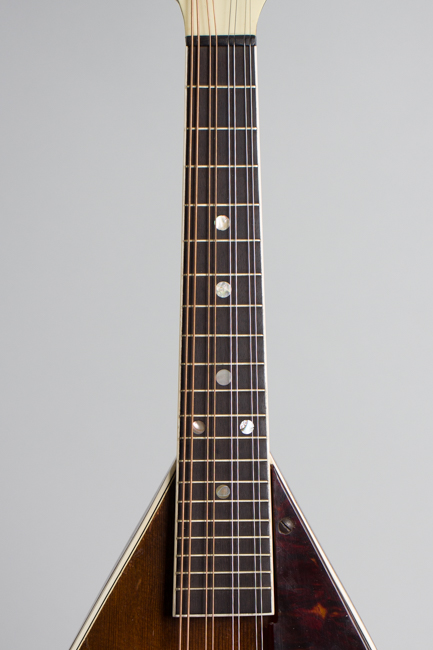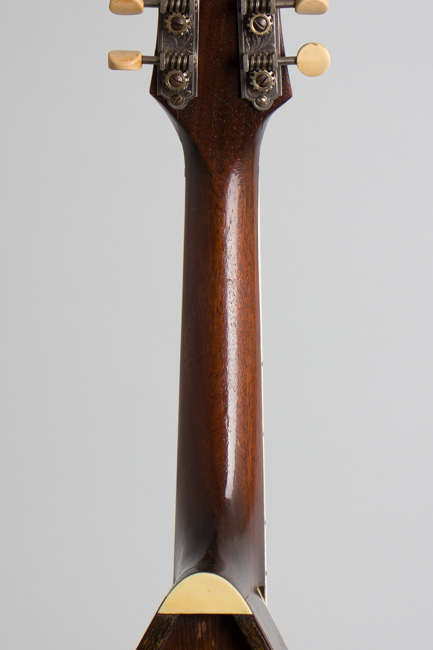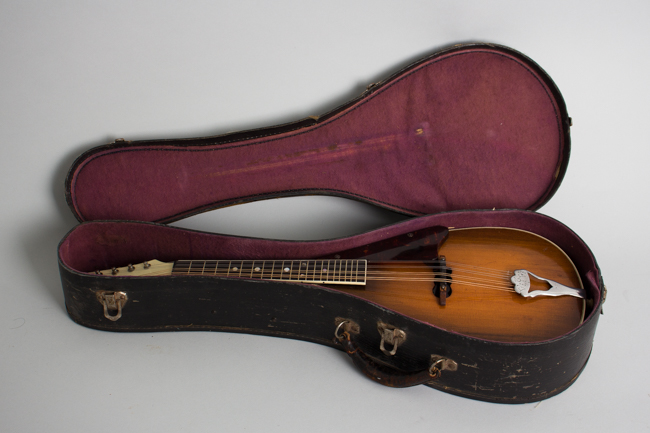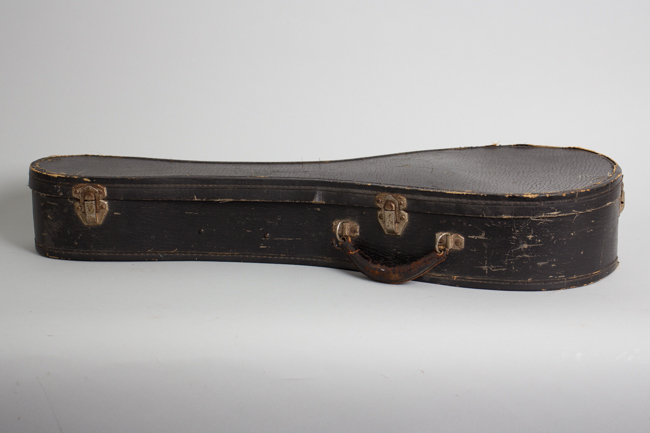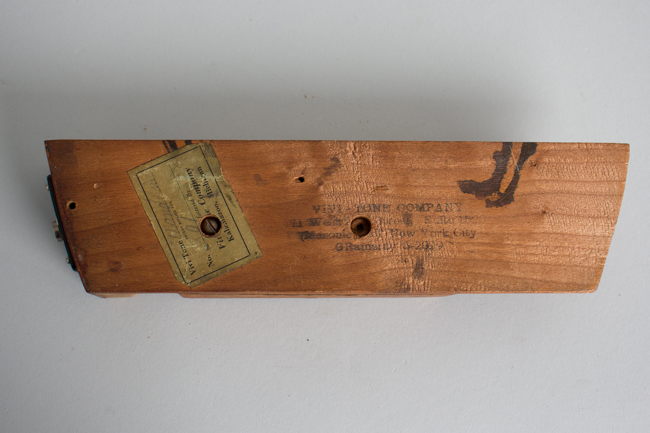Vivi-Tone Hollow Body Electric Mandolin (1933)
Vivi-Tone Hollow Body Electric Mandolin (1933), made in Kalamazoo, Michigan, serial # 301, brown sunburst lacquer finish, spruce top and back, birch ply sides; mahogany neck with ebony fingerboard, original black chipboard case.
This extremely rare Vivi-Tone electric mandolin is a superb example of Lloyd Loar's pioneering efforts in the creation of electric fretted instruments, as well as one of the earliest electric mandolins ever made, predated only by the virtually non-existent 1929 Stromberg-Voisinet electrics. Loar himself played primarily mandolin family instruments, so it seems likely this was a project he had more personal interest in at Vivi-Tone.
Loar and Williams both left Gibson over 1923-4. In the early 1930s Williams was bullish on the future of amplification, and Loar joined him by 1932 in launching the Vivi-Tone operation, initially to market radical solid "plank" bodied amplified instruments. As sales were minimal they quickly re-tooled their instruments to be capable of both acoustic and amplified sound hoping to appeal to more conservative players (maybe!). This mandolin actually has a decent amount of volume not plugged in.
This is a very well-made and playable mandolin embodying the unusual fruits of Loar's acoustic theories, even beyond the fascinatingly engineered if somewhat primitive pickup. This radical instrument almost turns the mandolin inside out; the thin arched solid spruce BACK is the soundboard as much as the heavy flat spruce top. The teardrop-shaped body has a subtle sunburst finish and heavy laminated rims, designed to prevent vibration with the back is recessed into them to avoid contact with the player. The only soundhole in the top is under the bridge, while the back carries two small f-holes.
The soft "V" mahogany neck has a Gibson-like feel with a bound ebony fingerboard and pearl dot inlay. The headstock shape is similar to the Loar-era "snakehead" Gibsons, ivoroid veneered on the face with a screened "Vivi-Tone" logo. The engraved Waverly strip tuners have grained ivoroid buttons. The top is triple bound, the heelcap is ivoroid. The cast tailpiece carries a very Art Nouveau "Vivi-Tone" logo; the pickguard is heavy tortoise celluloid raised above the rim. The substantial maple bridge has a compensated ebony cap.
The pickup is enclosed in a removable drawer which slides out of the bass side of the rim. Loar's design is a hybrid magnetic/electrostatic type with string vibration transmitted through the wooden bridge by two long screws to a metal plate atop a magnetic coil. This is not as efficient as the string-through horseshoe magnet design pioneered by Rickenbacker at the same time, but is functional. A jack is now mounted on the outside of the drawer; originally there was a hard-wired cloth cable.
The underside of this internal assembly is labeled "Vivi Tone Mandolin, Patent Applied For No. 301 Manufactured by Vivi Tone Company Kalamazoo, Michigan". An additional ink stamp on wood reads "Vivi-Tone Company 71 West 23th Street Suite 1520 Masonic Hall New York City Gramercy 5-2879". Phone calls to that number have failed to rouse comment from Lloyd's ghost. Interestingly Gibson's New York sales office was in the same building at that time; perhaps relations were more cordial than history records between them and their prodigal sons. At any rate his is a unique and playable piece of history, one of the rarest and flat-out coolest of all electric mandos.
Overall length is 27 in. (68.6 cm.), 9 1/2 in. (24.1 cm.) wide at lower bout, and 2 3/4 in. (7 cm.) in depth, measured at side of rim. Scale length is 14 7/8 in. (378 mm.).
This very rare instrument remains in generally excellent original and fully playable condition. The original finish shows light scratching, dings and dents overall, with some small ancient touch ups to a few dings on the top. There is a short repaired center grain crack in the top just behind the bridge, solid but visible, and a small lamination split on the headstock by the bass side tuners. There is a heavy plastic plate surrounding the phone jack that is not original; this replaced a hard-wired cord long ago.
The frets are in excellent shape, and the mandolin plays very well. The amplified sound is fairly low volume but pleasant enough, with more of an acoustic character than most later electric mandolins. The instrument still lives in its original heavy chipboard case, now 90 years old and looking futuristic and antique in equal measure. Overall Excellent - Condition.
This extremely rare Vivi-Tone electric mandolin is a superb example of Lloyd Loar's pioneering efforts in the creation of electric fretted instruments, as well as one of the earliest electric mandolins ever made, predated only by the virtually non-existent 1929 Stromberg-Voisinet electrics. Loar himself played primarily mandolin family instruments, so it seems likely this was a project he had more personal interest in at Vivi-Tone.
Loar and Williams both left Gibson over 1923-4. In the early 1930s Williams was bullish on the future of amplification, and Loar joined him by 1932 in launching the Vivi-Tone operation, initially to market radical solid "plank" bodied amplified instruments. As sales were minimal they quickly re-tooled their instruments to be capable of both acoustic and amplified sound hoping to appeal to more conservative players (maybe!). This mandolin actually has a decent amount of volume not plugged in.
This is a very well-made and playable mandolin embodying the unusual fruits of Loar's acoustic theories, even beyond the fascinatingly engineered if somewhat primitive pickup. This radical instrument almost turns the mandolin inside out; the thin arched solid spruce BACK is the soundboard as much as the heavy flat spruce top. The teardrop-shaped body has a subtle sunburst finish and heavy laminated rims, designed to prevent vibration with the back is recessed into them to avoid contact with the player. The only soundhole in the top is under the bridge, while the back carries two small f-holes.
The soft "V" mahogany neck has a Gibson-like feel with a bound ebony fingerboard and pearl dot inlay. The headstock shape is similar to the Loar-era "snakehead" Gibsons, ivoroid veneered on the face with a screened "Vivi-Tone" logo. The engraved Waverly strip tuners have grained ivoroid buttons. The top is triple bound, the heelcap is ivoroid. The cast tailpiece carries a very Art Nouveau "Vivi-Tone" logo; the pickguard is heavy tortoise celluloid raised above the rim. The substantial maple bridge has a compensated ebony cap.
The pickup is enclosed in a removable drawer which slides out of the bass side of the rim. Loar's design is a hybrid magnetic/electrostatic type with string vibration transmitted through the wooden bridge by two long screws to a metal plate atop a magnetic coil. This is not as efficient as the string-through horseshoe magnet design pioneered by Rickenbacker at the same time, but is functional. A jack is now mounted on the outside of the drawer; originally there was a hard-wired cloth cable.
The underside of this internal assembly is labeled "Vivi Tone Mandolin, Patent Applied For No. 301 Manufactured by Vivi Tone Company Kalamazoo, Michigan". An additional ink stamp on wood reads "Vivi-Tone Company 71 West 23th Street Suite 1520 Masonic Hall New York City Gramercy 5-2879". Phone calls to that number have failed to rouse comment from Lloyd's ghost. Interestingly Gibson's New York sales office was in the same building at that time; perhaps relations were more cordial than history records between them and their prodigal sons. At any rate his is a unique and playable piece of history, one of the rarest and flat-out coolest of all electric mandos.
Overall length is 27 in. (68.6 cm.), 9 1/2 in. (24.1 cm.) wide at lower bout, and 2 3/4 in. (7 cm.) in depth, measured at side of rim. Scale length is 14 7/8 in. (378 mm.).
This very rare instrument remains in generally excellent original and fully playable condition. The original finish shows light scratching, dings and dents overall, with some small ancient touch ups to a few dings on the top. There is a short repaired center grain crack in the top just behind the bridge, solid but visible, and a small lamination split on the headstock by the bass side tuners. There is a heavy plastic plate surrounding the phone jack that is not original; this replaced a hard-wired cord long ago.
The frets are in excellent shape, and the mandolin plays very well. The amplified sound is fairly low volume but pleasant enough, with more of an acoustic character than most later electric mandolins. The instrument still lives in its original heavy chipboard case, now 90 years old and looking futuristic and antique in equal measure. Overall Excellent - Condition.
